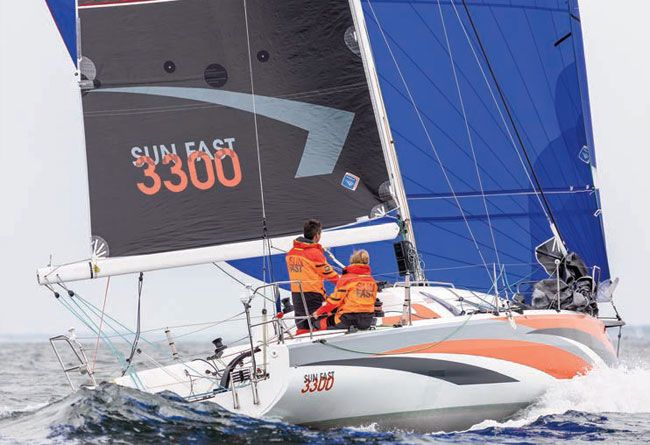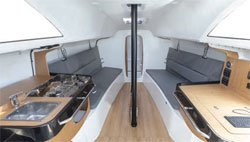

When Daniel Andrieu and Guillaume Verdier designed a new shorthanded racer for Jeanneau even they couldn’t have dreamt what a stunning success they were about to set in motion
No less than 70 Sun Fast 3300s have been built, with fleets in the UK, France, Norway, Australia and the USA. As many as 15 will be on the start of the Fastnet later this year. Being a veteran double-handed campaigner himself, Nigel Colley of Sea Ventures in Swanwick, UK, will be ready to support any and all who are interested in double-handed sailing, this newest and most exciting sector of our sport.
Whether an aspiring Olympian, a keen amateur tired of full-crew racing, a couple looking for a new way to enjoy sailing, or any other number of different permutations, the Sun Fast 3300 rises as the perfect choice for two-handed sailing. Its clever full-bow hull design from designers Andrieu and Verdier extends waterline length, and the water ballast tanks add to stability. The generous sail area set in the large foretriangle both reduces weather helm and gives plenty of versatile sail power when needed. Large bowsprit-borne asymmetrical spinnakers and Code Zeros in the downwind sailplan propel the boat at impressive offwind speeds.
To say the growth in popularity of the short-handed racing scene is brisk is, by now, almost a cliché. Expanding beyond the traditional arenas of interest around La Manche, and not counting the pro and semipro enthusiasts who are already hooked, there are four key factors that have helped propel this trend worldwide towards new participants:
Below: the simple but comfortable and very practical interior layout makes the Sun Fast 3300 a capable and enjoyable cruiser as well as fully optimised offshore racer

- Promotion: The widespread access to vast multimedia resources has put the Vendée Globe onto nearly every screen in the sailing world. The fundamental appeal of the man vs nature story will never tire, especially when technology has advanced the boats’ speeds in such profound and dramatic ways. One can safely assume this spectacle will inspire the next generation of offshore stars.
- Politics: World Sailing has finally amassed support for a new offshore sailing medal discipline in the 2024 Olympics. With its strong media following, France is the perfect venue to support offshore sailing, and interest will automatically be spread among all nations interested in fielding a team. However, the devil still lies in the details: what equipment will be used, how will national team selections be run, and will the IOC even give its final approval in May.
- Pandemic: Local restrictions vary, but in many areas of the globe the ability to get out and enjoy sailing or racing has been curtailed in the past year or limited to household-only crews. Race organisers have tried to adapt by offering no-host races, and this was quite popular last season and may likely continue well into the spring and summer. Many have discovered they rather like not having to rustle together a large crew and with help from their own family or close friends they have rediscovered an activity they probably used to enjoy before getting sucked into full-crew racing.
- Practicality: Even before the pandemic hit, big-boat racing owners were tiring of the hassle and expense of fielding a full crew every time going out to race. Racing with a smaller team has appeals to those who want to go on either short or long duration races with either modified and adapted versions of the boats they have or with the purchase of new model options in the marketplace now that appeal directly to this new group of enthusiasts. Whether racing around an island in their local bay or planning to do the Fastnet course, the enormous growth in popularity suggests this could be the fastest growing sector in racing and cruiser/racer sailing today.
This interest is manifested in more than just high-profile one-design class racing, but also racing under IRC or ORC handicaps as well. Last year there were more than 2,000 ORC DH certificates issued in several countries in Europe, Australia and the US, and ORC has structured a new annual double-handed European Championship event: this year’s edition will be in Greece and next year’s will be at the Round Gotland Race in Sweden.
In the IRC world, the UK’s Double- Handed Offshore Series is growing fast, where in this fleet there is some significant UK sailing star talent: Shirley Robertson, Dee Caffari, Stuart Childerley and Henry Bromby are a few. There are also dozens of entries expected in double-handed classes that will be out on the new Fastnet racecourse this year.
In the USA there are both new races – like the Annapolis Double- Handed Race – and established ones held in regions from Florida to Newport, the Great Lakes, Gulf Coast and West Coast where new doublehanded classes have helped boost fleet participation numbers. Even the 2,225-mile biennial Transpac race from LA to Hawaii may once again have enough double-handed entries to form their own class.
Click here for more information on Sea Ventures »
We invite you to read on and find out for yourself why Seahorse is the most highly-rated source in the world for anyone who is serious about their racing.
To read on simply SIGN up NOW
Take advantage of our very best subscription offer or order a single copy of this issue of Seahorse.
Online at:
www.seahorse.co.uk/shop and use the code TECH20
Or for iPad simply download the Seahorse App at the iTunes store


